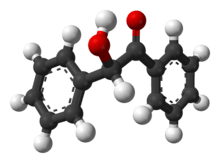Benzoin (organic compound)
Benzoin (/ˈbɛnzoʊ.ɪn/ or /-ɔɪn/) is an organic compound with the formula PhCH(OH)C(O)Ph. It is a hydroxy ketone attached to two phenyl groups. It appears as off-white crystals, with a light camphor-like odor. Benzoin is synthesized from benzaldehyde in the benzoin condensation. It is chiral and it exists as a pair of enantiomers: (R)-benzoin and (S)-benzoin.
 | |
 | |
| Names | |
|---|---|
| Preferred IUPAC name
2-Hydroxy-1,2-diphenylethan-1-one | |
| Other names
2-Hydroxy-2-phenylacetophenone 2-Hydroxy-1,2-diphenylethanone Desyl alcohol Bitter almond oil camphor | |
| Identifiers | |
3D model (JSmol) |
|
| 3DMet | |
| 391839 | |
| ChEBI | |
| ChEMBL | |
| ChemSpider | |
| ECHA InfoCard | 100.003.938 |
| KEGG | |
PubChem CID |
|
| RTECS number |
|
| UNII | |
CompTox Dashboard (EPA) |
|
| |
| |
| Properties | |
| C14H12O2 | |
| Molar mass | 212.248 g·mol−1 |
| Appearance | Off-white crystals |
| Density | 1.31 g/cm3 |
| Melting point | 134 to 138 °C (273 to 280 °F; 407 to 411 K) |
| Boiling point | 344 °C (651 °F; 617 K) |
| Slightly soluble | |
| Solubility in ethanol | Slightly soluble |
| Solubility in alcohol | Soluble |
| Solubility in ether | Slightly soluble |
| Solubility in chlorine | Soluble |
| Hazards | |
GHS hazard statements |
H412 |
| P273, P501 | |
| NFPA 704 (fire diamond) | |
| Lethal dose or concentration (LD, LC): | |
LD50 (median dose) |
10.000 mg/kg |
Except where otherwise noted, data are given for materials in their standard state (at 25 °C [77 °F], 100 kPa). | |
| Infobox references | |
Benzoin is not a constituent of benzoin resin obtained from the benzoin tree (Styrax) or tincture of benzoin. The main component in these natural products is benzoic acid.
History
Benzoin was first reported in 1832 by Justus von Liebig and Friedrich Woehler during their research on oil of bitter almond, which is benzaldehyde with traces of hydrocyanic acid.[1] The catalytic synthesis by the benzoin condensation was improved by Nikolay Zinin during his time with Liebig.[2][3]
Uses
The main uses of benzoin are as a precursor to benzil, which is a photoinitiator.[4] The conversion proceeds by organic oxidation using copper(II),[5] nitric acid, or oxone. In one study, this reaction is carried out with atmospheric oxygen and basic alumina in dichloromethane.[6]
Benzoin can be used in the preparation of several pharmaceutical drugs including oxaprozin, ditazole, and phenytoin.[7]
Preparation
Benzoin is prepared from benzaldehyde via the benzoin condensation.[8]
References
- Wöhler, Liebig; Liebig (1832). "Untersuchungen über das Radikal der Benzoesäure". Annalen der Pharmacie. 3 (3): 249–282. doi:10.1002/jlac.18320030302. hdl:2027/hvd.hxdg3f.
- N. Zinin (1839). "Beiträge zur Kenntniss einiger Verbindungen aus der Benzoylreihe". Annalen der Pharmacie. 31 (3): 329–332. doi:10.1002/jlac.18390310312.
- N. Zinin (1840). "Ueber einige Zersetzungsprodukte des Bittermandelöls". Annalen der Pharmacie. 34 (2): 186–192. doi:10.1002/jlac.18400340205.
- Hardo Siegel, Manfred Eggersdorfer "Ketones" in Ullmann's Encyclopedia of Industrial Chemistry Wiley-VCH, 2002 by Wiley-VCH, Wienheim. doi:10.1002/14356007.a15_077
- Clarke, H. T.; Dreger.E. E. (1941). "Benzil". Organic Syntheses.; Collective Volume, 1, p. 87
- Konstantinos Skobridis; Vassiliki Theodorou; Edwin Weber (2006). "A very simple and chemoselective air oxidation of benzoins to benzils using alumina". Arkivoc. 06-1798JP: 102–106.
- U.S. Patent 2,242,775
- Clarke, H. T.; Dreger.E. E. (1941). "Benzil". Organic Syntheses.; Collective Volume, 1, p. 87
External links
- Benzoin synthesis, Organic Syntheses, Coll. Vol. 1, p. 94 (1941); Vol. 1, p. 33 (1921)
